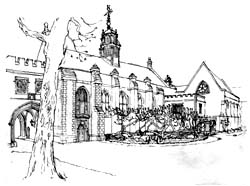Ten Years of the Sacred Land Project
John Smith of ARC, at Lambeth, 2005:
I was in the wrong place at the right time when I was asked to head ARC’s Sacred Land Project and although there was a great demand for the project it did take a lot of time persuading both Local Authority Departments and conservation bodies that neither “faith” nor “sacred sites” had to be referred to only in the past tense. And that the term “sacred” wasn’t scary.
Whether they are old or new, sacred sites have always been and will always be part of our landscape. And as I had to point out to the sceptical, you don’t have to be a believer to recognise this.
 |
 |
 |
Morton's Fig at Lambeth Palace. Copyright Richard Prime. |
It wasn’t just the secular bodies who needed to adapt. When I was working with the religious communities on funding applications I did occasionally have the task of explaining to that if you answered questions about a project’s rationale with the statement “because we are guided by God” it might not tick the right boxes for the funding authority
When we were trying to save what seemed to some people to be a puddle of water – and for others the rationale for a history of pilgrimage – there was always, thankfully, plenty of support from WWF, and the mere mention of their name often meant that at least I got a polite listening. That was usually enough, because once you got the chance to tell the story even the most ardent materialist begun to take note.
Sacred Land helped change the landscape and now most conservation bodies like to talk about their commitment to protect what people value rather than simply what they think should be valued. This is not to deny anyone’s values – whether they are from the secular or faith communities - but to recognise that landscapes are layered and shared and mostly there is room for everyone.
So again in partnership with WWF last year we got the Worlds Parks Congress, which is the foremost assembly concerned with protected areas, to recognise the legitimacy of recognising sacred sites - which meant that the partnership of religion and conservation could take a major step forward.
|

